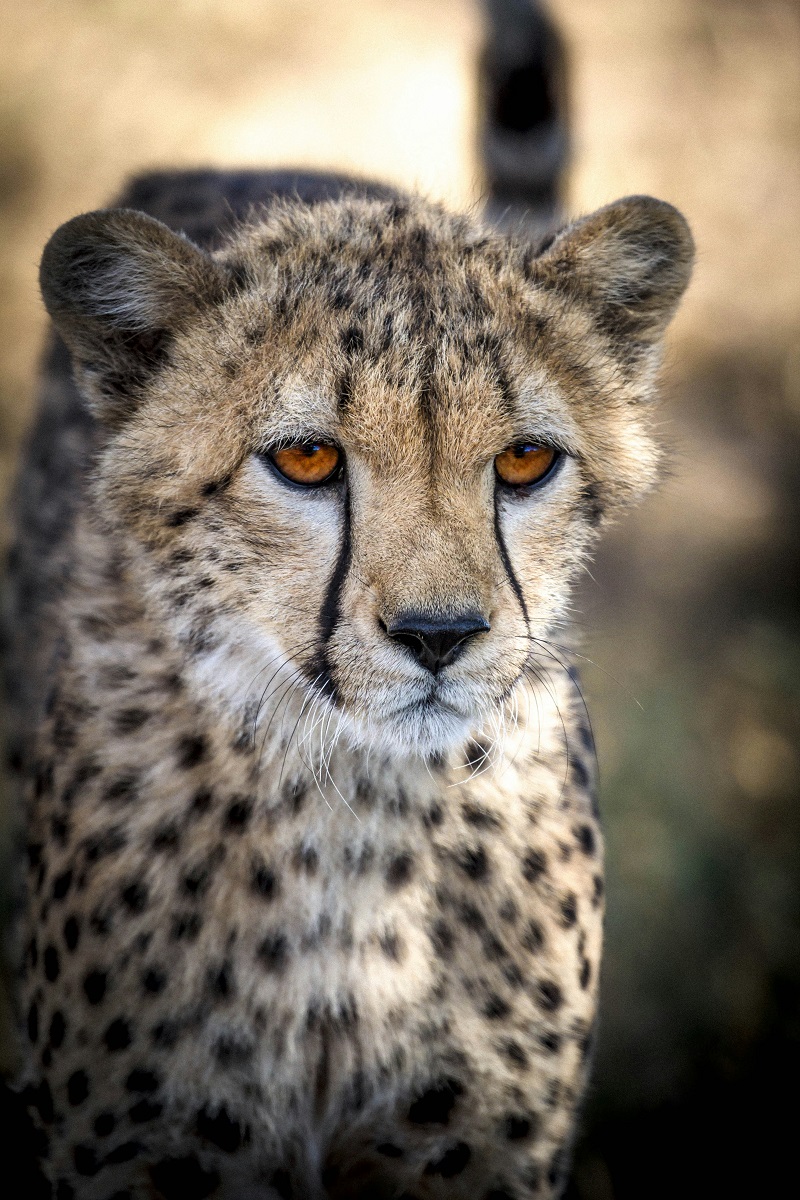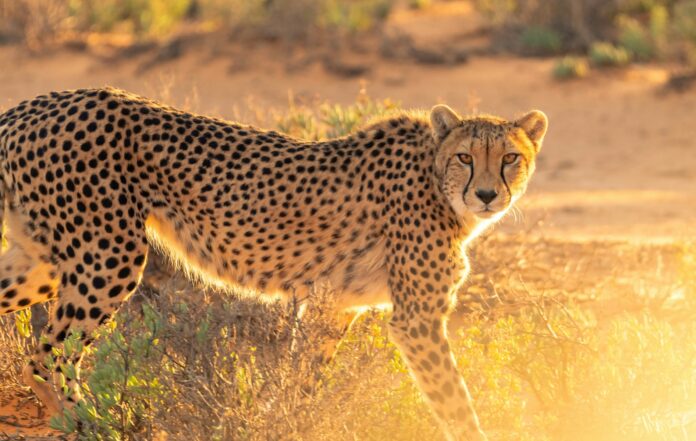Summary: The cheetah is the fastest land animal on Earth, capable of reaching speeds up to 70 mph (113 km/h) in short bursts. Native to Africa and parts of Iran, cheetahs are known for their slender build, distinctive black tear markings, and golden fur with black spots. Unlike other big cats, cheetahs cannot roar, but they purr and chirp. They rely on speed and stealth to hunt prey, primarily antelope and small mammals. Cheetahs are currently vulnerable due to habitat loss, human-wildlife conflict, and a limited genetic pool, making conservation efforts crucial for their survival.
The cheetah (Acinonyx jubatus) is one of the most awe-inspiring creatures on the planet, an embodiment of grace, speed, and specialized evolution. Revered for being the fastest land animal in the world, this big cat is also one of the most vulnerable. Behind its athletic elegance lies a delicate struggle for survival, with threats from habitat loss, shrinking gene pools, and human conflict. This comprehensive guide explores everything you need to know about cheetahs: their biology, behavior, habitat, conservation status, and their irreplaceable role in nature.
Introduction
While these species are globally famous for their sprinting ability, there’s much more to this feline than speed alone. With a sleek, aerodynamic body, they have evolved to chase prey in short, explosive bursts, an adaptation no other predator has achieved to this extent. Yet, this specialization makes them fragile in many other areas: they aren’t as strong as lions, as adaptable as leopards, or as powerful as tigers. Instead, they’ve become a perfect example of evolutionary trade-offs: excelling in one area while sacrificing others.
Physical Characteristics
Every part of their body is designed for speed. Adults typically weigh between 75 and 125 pounds (34 to 57 kg) and measure 3.5 to 4.5 feet (1.1 to 1.4 meters) in body length, with an additional 2 to 3 feet (60 to 80 cm) in tail length. Their bodies are long and lean, with a deep chest, a small, rounded head, and long, slender limbs.
Key physical adaptations include
Flexible Spine: Works like a spring, allowing extreme flexion and extension during a run.
Non-Retractable Claws: Provide constant traction, similar to track spikes worn by sprinters.
Oversized Nostrils and Lungs: Ensure maximum oxygen intake during high-speed chases.
Large Adrenal Glands: Deliver rapid bursts of energy when needed.
Tail as a Rudder: Helps balance and steer mid-run, especially during high-speed turns.
Cheetahs also feature distinctive black “tear marks” that run from the inner corners of their eyes to the sides of their mouth. These help reduce sun glare and enhance focus while stalking prey.

Habitat and Range
Cheetahs thrive in wide-open spaces, preferring savannas, dry forests, semi-deserts, and open grasslands that allow them to spot prey from a distance and launch high-speed pursuits. Historically, cheetahs had a wide range that stretched from the African continent to the Middle East and as far as India. Today, they are mostly confined to sub-Saharan Africa, with small, critically endangered populations in Iran (known as the Asiatic cheetah).
These animals require large territories, sometimes hundreds of square kilometers, especially females, who roam widely in search of prey and safe denning sites. Habitat loss, driven by agriculture, infrastructure development, and human settlements, has drastically reduced the land available to them, making conservation of open landscapes critical.
Behavior and Social Structure
Cheetah behavior is unique among big cats. Unlike lions that live in large prides or leopards that maintain solitary yet defined territories, cheetahs display a mix of social patterns:
Females are solitary except when raising cubs. They roam extensively and establish temporary home ranges.
Males, especially siblings from the same litter, often form small, stable groups that defend territories together, which enhances their chances of mating and survival.
These social structures impact hunting, movement, and mating behaviors. Cheetahs communicate using chirps, purrs, growls, hisses, and body language. They’re not particularly aggressive and will avoid confrontation when possible, preferring flight over fight.
Diet and Hunting Techniques
Cheetahs are obligate carnivores and primarily hunt medium-sized ungulates, such as:
Thomson’s gazelle
Impala
Springbok
Young wildebeest
Hares and small antelopes
The cheetah’s hunting strategy relies on stealth and speed. First, the cat will stalk its prey to within 60–100 feet (18–30 meters), using tall grasses or low shrubs as cover. Then, it explodes into a full-speed chase, using its tail to make sudden turns and its claws for traction. The sprint usually lasts less than 30 seconds, and if successful, the cheetah will trip the prey using a swipe of its front paw, then suffocate it with a bite to the throat.
After a successful hunt, the cheetah must eat quickly. Unlike lions or hyenas, cheetahs are poor at defending their kills and will often be chased off by stronger predators.
Reproduction and Cubs
Cheetahs breed year-round, with a gestation period of about 90 to 95 days. Females typically give birth to 3 to 5 cubs, although litters can be as large as 8. Cheetah cubs are born blind and helpless, weighing only 9–11 ounces (250–350 grams).
For the first few months, mothers move the cubs frequently to avoid detection by predators. Cubs begin eating solid food around six weeks of age and will stay with their mother for up to 18 months, during which time they learn to hunt and avoid danger. Unfortunately, cheetah cub mortality is extremely high, often exceeding 50%, due to predation by lions, leopards, hyenas, and even large birds of prey.
Conservation Status
According to the IUCN Red List, the cheetah is classified as Vulnerable, with only around 7,000 individuals left in the wild. The Asiatic cheetah is critically endangered, with fewer than 50 individuals remaining in Iran.
Major threats include:
Habitat fragmentation from farming and development
Human-wildlife conflict, especially with livestock owners
Poaching and illegal trade, including cheetah cub trafficking for exotic pets
Low genetic diversity makes them more susceptible to disease and reproductive issues
Conservation groups like the World Wildlife Fund and the African Wildlife Foundation are working to protect cheetah habitats, support sustainable coexistence with local communities, and combat illegal wildlife trafficking.
Cheetahs in Captivity and Education
Captive breeding programs and wildlife reserves play a crucial role in the long-term survival of cheetahs. Zoos and sanctuaries such as the Smithsonian’s National Zoo help maintain genetic diversity and educate the public about the importance of big cat conservation.
However, cheetahs do not breed easily in captivity, and their unique needs mean that they cannot simply be reintroduced into the wild without careful planning and support. Conservationists agree that preserving wild populations and their ecosystems is the top priority.
Frequently Asked Questions
How fast can a cheetah run?
Cheetahs can run up to 70 mph (113 km/h) in short bursts, making them the fastest land animals.
Where do cheetahs live?
Cheetahs primarily live in parts of sub-Saharan Africa, with a small population also found in Iran.
What do cheetahs eat?
Cheetahs mainly hunt small to medium-sized animals such as gazelles, impalas, and hares.
Can cheetahs roar?
No, unlike other big cats, cheetahs cannot roar. They communicate through purrs, chirps, growls, and hisses.
Why do cheetahs have tear marks?
The black tear markings under a cheetah’s eyes help reduce glare from the sun and improve focus while hunting.
Are cheetahs endangered?
Cheetahs are classified as vulnerable due to habitat loss, human conflict, and low genetic diversity.
How long do cheetahs live?
In the wild, cheetahs live around 10 to 12 years, while in captivity they can live up to 17 years.
Do cheetahs live in groups?
Male cheetahs sometimes form small groups called coalitions, usually with siblings, while females are more solitary.
How do cheetahs catch their prey?
Cheetahs use stealth to get close to prey and then sprint at high speeds to chase and trip them with their front legs.
What threats do cheetahs face?
Major threats include habitat fragmentation, poaching, livestock conflict, and inbreeding due to low population diversity.

